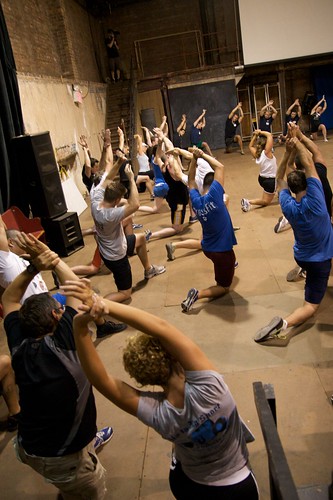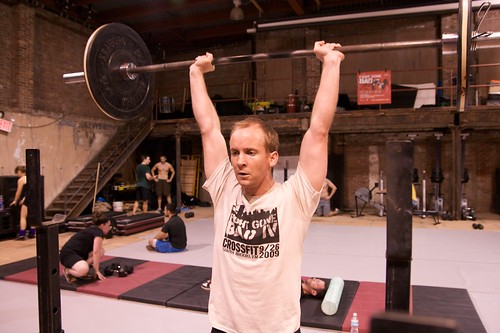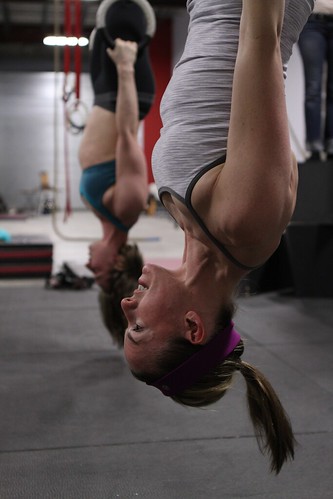
Today's article is for all the newly minted CrossFit coaches out there, eager to share their enthusiasm and passion for fitness with the world. I can't express how much happiness, fulfillment, and fun I've derived from coaching people over the last 10 or so years. On top of that, I've been able to create a career that allows me to spend time with people I care deeply about, doing the things I love, while making a comfortable, consistent living. Yet even after about a decade in the "industry," six years of running a CrossFit affiliate, thousands of coaching hours, and countless lessons learned in the process, I still consider myself a young coach with a lot left to learn—a disposition I hope to maintain for years to come. That being said, there are a few basic principles and challenges I'd like to offer up to anyone just starting their journey as a coach and student of fitness.
Walk Before You Run
In my opinion, CrossFit is the most technically demanding physical exercise available to the general population, and thus, the most technically demanding to coach. A seasoned CrossFit coach should have the competency to work with a vast range of individuals, spanning the range of body types, abilities, and goals. Additionally, CrossFit coaches need to be able to teach the fundamentals of powerlifting, Olympic weightlifting, rudimentary gymnastic skills, as well as endurance sports—often within a single day or even session. When I started CrossFit, I had minimal experience with any of these disciplines and my first impressions as a young coach were, "Well, shit, I've got a lot to learn here."
 A 2009 L1 Cert we hosted in our previous location.So, to that end, I devoured the early CrossFit Journal articles, read Starting Strength: Basic Barbell Training and Olympic Weightlifting: A Complete Guide for Athletes & Coaches, trained at a weightlifting gym, attended seminars, and to light even more of a fire under my ass, I signed up for an Olympic weightlifting meet. Despite several previous years working in a personal training format, I knew that I didn't yet have the experience and skill set required to perform, coach, and teach everything in a way that would do justice to my idea of CrossFit. That idea was influenced by Greg Glassman’s essay, “Fundamentals, Virtuosity, and Mastery,” in which he insists that one should perform the common uncommonly well. I started slow with my clients, and gradually all of them learned proper execution of calisthenics, barbell pressing, squatting, and deadlifting. I started writing simple WODs comprised of low skill movements, which I knew I had the ability to teach properly and provide meaningful feedback on.
A 2009 L1 Cert we hosted in our previous location.So, to that end, I devoured the early CrossFit Journal articles, read Starting Strength: Basic Barbell Training and Olympic Weightlifting: A Complete Guide for Athletes & Coaches, trained at a weightlifting gym, attended seminars, and to light even more of a fire under my ass, I signed up for an Olympic weightlifting meet. Despite several previous years working in a personal training format, I knew that I didn't yet have the experience and skill set required to perform, coach, and teach everything in a way that would do justice to my idea of CrossFit. That idea was influenced by Greg Glassman’s essay, “Fundamentals, Virtuosity, and Mastery,” in which he insists that one should perform the common uncommonly well. I started slow with my clients, and gradually all of them learned proper execution of calisthenics, barbell pressing, squatting, and deadlifting. I started writing simple WODs comprised of low skill movements, which I knew I had the ability to teach properly and provide meaningful feedback on.
Over time, my skill set grew and I began introducing advanced movements, including Olympic weightlifting and more nuanced gymnastics. I learned to identify my most effective progressions and cues, developed my eye, and paid attention to what did and didn't seem to be working—all through seeing how my clients were performing. Even in the infancy of my affiliate, until I got a better handle on teaching groups the elements I'd already applied to my individual clients, I biased lower skill but still potent workouts. This spirit of finding best practices is still part of our ethos at CFSBK, where our entire coaching staff works together to evolve both how we write programming and execute it in group classes.
I believe a good coach earns the ability to teach movement—they don't presume it. I encourage you to start by developing a personal understanding and appreciation of the skills you're going to be teaching, and then slowly implement them into your coaching, both one-on-one and in group formats. It's totally okay not to be teaching everything under the CrossFit sun in the beginning. Start with what you know and then get really good at teaching the fundamentals. After you've got a handle on your personal pedagogy, you can start to layer on more advanced skills. Trust me, it is okay if your early programming is very basic. Your clients won't run away because they're not working snatch and muscle-up progressions immediately. Respect the process and take the long, worthwhile road to becoming an excellent coach.
 Make It Your Own
Make It Your Own
There is no shortage of CrossFit programming available for free online. As with most things on the Internet, they can range from phenomenally effective to irresponsible and dangerous. It's easy to pick up a program and follow along in the passenger's seat, but I encourage all new coaches to take the time to write their own programming for their athletes. Instead of copy and pasting programs you like, instead attempt to find common themes that you think make certain programs effective and apply them to your own training situations. Really think hard about it, and challenge yourself to develop a programming philosophy and style. There is an art and science to programming that can't quite be honed outside of trial and error experimentation. The mindful practice of writing programs forces you to think about WHY you're doing what you're doing, which helps you grow as a coach.
Below are some questions that can help you develop your own programming philosophy and style. I’ve included some short responses below the questions to help you brainstorm.
First, generally define your audience.
At our gym, it’s mostly 25-45-year-old working professionals that spend most of their days sitting in front of computer screens. The majority of our population joined our gym in order to get in better shape and participate in an effective and engaging fitness program.
What is the intent of your programming?
Well, it’s CrossFit. We want people to be well-rounded and fit. Most of our members come in lacking basic strength and our advanced athletes require even more strength to continue pushing their broader adaptations—therefore the proverbial meat and potatoes of our program is progressive barbell training and basic calisthenics. Given the size of our population (about 600 members), we also offer leveled programming to help accommodate for the different needs and abilities of members.
 Even simple gymnastics require good coaching.How does what I'm planning on doing today fit into a larger training context?
Even simple gymnastics require good coaching.How does what I'm planning on doing today fit into a larger training context?
We program in cyclical eight-week training templates where we target particular performance objectives. The strength training and overarching goals of the macro cycle are laid out initially, and the conditioning is written about one to two weeks in advance. This way, we can minimize training interference with the cycles’ primary goals and ensure that we’re providing a well-rounded dosage of movements and time domains.
What are the obstacles for implementing this programming at my affiliate given my budget, equipment, space, and average class size?
When I started out, my initial budget for the affiliate was about $150, and all of the equipment had to be able to be carried (not driven) from my apartment to the park where I started. Because of that, our programming included lots of body weight movements, jumping rope, and running. Currently, we don't have equipment or coaching constraints, but are dealing with space constraints because our membership size has grown, and thus we have to program to accommodate larger class sizes.
What are my own coaching strengths and limitations?
At this point, I'm quite comfortable teaching the full range of CrossFit movements, with a special interest in Olympic lifting and inversions. My weakest skill set is in coaching running and endurance training. Luckily, we have a great staff of coaches and network beyond our gym I can defer to when needed.
Concluding Thoughts
There is an endless list of qualities that make a good coach. This letter is just the tip of the iceberg when it comes to what I think it takes to become effective and exceptional. It’s okay to be scared at first, and it’s okay to be nervous. In fact, you probably should be a little scared and nervous, because as a coach, you have the capacity to become a very influential person in someone’s life, either for better or worse. How positively you influence someone hinges on your ability to know yourself as a coach—and requires a willingness to acknowledge your limitations and remain committed to getting better.
So: keep asking yourself how you can get better. Become so exceptional that no one else will ever be able to work with your population as well as you can. There are so many experts and resources and so much great information that will help you along the way—and people who will show up to help you—but you are responsible for becoming your own expert. At the end of the day, follow your intuition, learn to empathize with a variety of different people, and fall madly in love with your awesome new job. We can’t wait to hear how it goes, and ITA will be along for the ride.
__________________
Seasoned CrossFit coaches out there: what’s one great lesson you learned when you were starting out?